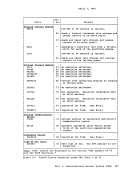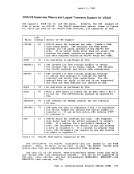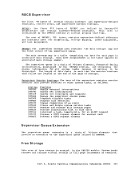April 1, 1981
The length of the associated data or buffer is specified in
theVMCPLENA field. VMCPLENA contains the length of the data sent by a user, the length of
aRECEIVE buffer, or the length of an external interrupt
buffer, whichever is specified in the fieldVMCPVADA. The
size of the value specified inVMCPLENA is restricted only by
virtualmachine storage size. The sink virtual machine can use the value in this field as
the data length forRECEIVE operations. VMCPVADB Contains the address of a source virtual machine's REPLY buffer for a SEND/RECV request. When the sink virtual machine
issues aREPLY in response to a SEND/RECV from the source
virtual machine, theREPLY data is moved in this buffer. The
length of theREPLY buffer is contained in the field VMCPLENB. VMCPLENB Specifies the length of the source virtual machine's REPLY buffer. The sink virtual machine uses this field to determine
the maximum length of theREPLY. A corresponding field within
the response message header contains a residual data count.
The source virtual machine uses this residual
determine the length of the sink reply. The originalREPLY buffer length (less the residual count) is the length of the REPLY from the sink virtual machine. VMCPUSE contains the VMCF user doubleword. The user doubleword is
transmitted to .the sink virtual machine in theSEND message
header forSEND, SEND/RECV, SENDX, and IDENTIFY requests. For RECEIVE, REPLY, and REJECT requests, the user doubleword is
transmitted to the source virtual machine within theRESPONSE message header. The sink virtual machine can transmit the
user doubleword to the source virtual machine with REJECT orREPLY requests only if the original request was a SEND/RECV. The user doubleword is transmitted only with requests that
result in'SEND or RESPONSE external interrupts.
The following chart summarizes theVMCPARM fields required for
execution of each of theVMCF subfunctions. Possible return
codes associated with each subfunction are also listed. A
discussion of the return codes and their meanings can be found
in the section"DIAGNOSE X'0068' RETURN CODES." 162 IBM VM/3 7 0 System Programmer's Guide
The length of the associated data or buffer is specified in
the
a
buffer, whichever is specified in the field
size of the value specified in
virtual
the data length for
issues a
virtual machine, the
length of the
the maximum length of the
the response message header contains a residual data count.
The source virtual machine uses this residual
determine the length of the sink reply. The original
transmitted to .the sink virtual machine in the
header for
transmitted to the source virtual machine within the
user doubleword to the source virtual machine with REJECT or
result in
The following chart summarizes the
execution of each of the
codes associated with each subfunction are also listed. A
discussion of the return codes and their meanings can be found
in the section















































































































































































































































































































































































































































